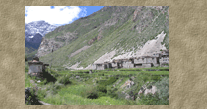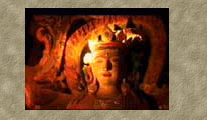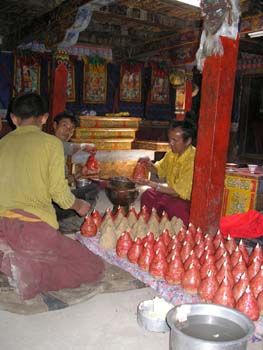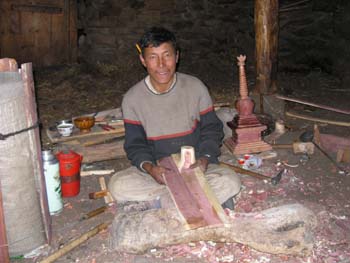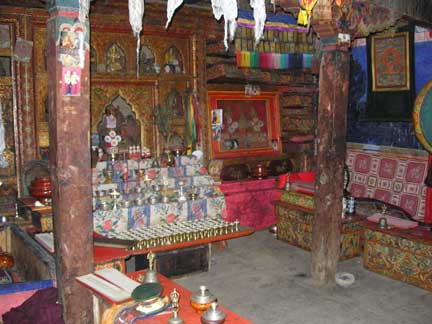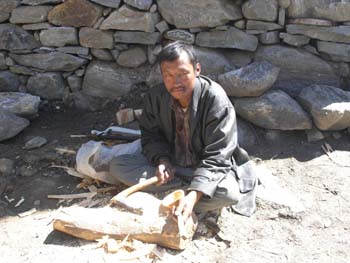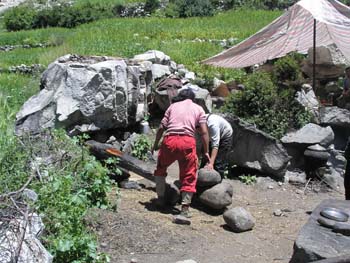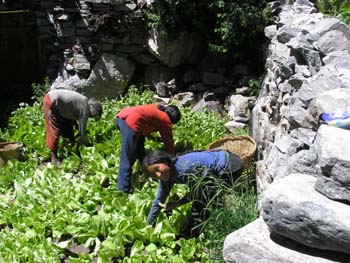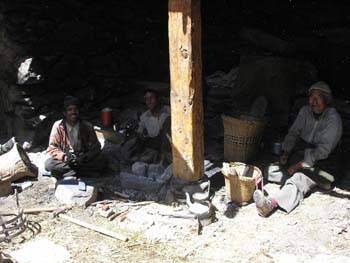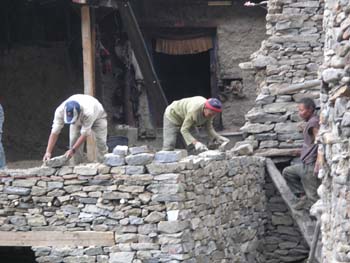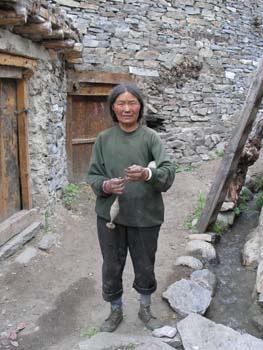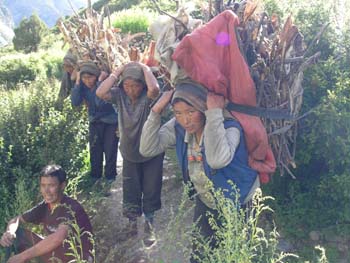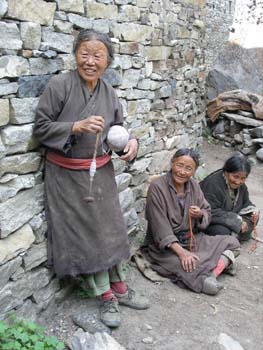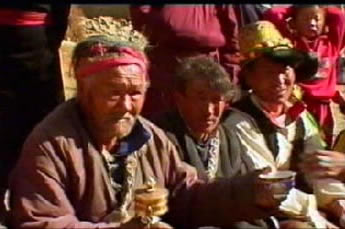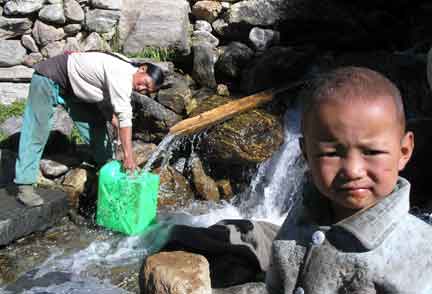What The Villagers
Do For Living |
|
| Process
of making Tsempa |
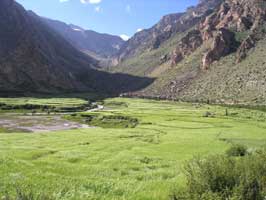
|
The people Limi grows barley, bean,
wheat, mustard, and some vegetables in their farmlands.
Among these, barley is the main corps and is the main diet
of all Tibetan people.
Barley can be made "Tsempa":
roasted barley flour, and "Chang": barley wine.
These two are the most consumed by the people.
|
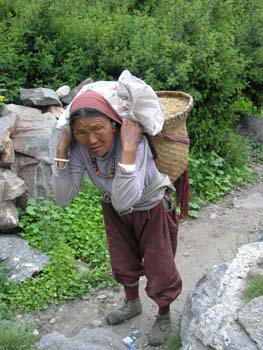 |
This woman is carrying a basket full of
barley after she has washed and socked the barley into a river.
Now, the socked barley
has to dry off half way through. So, it is easy to roast.
|
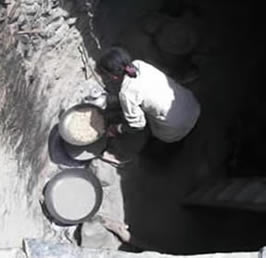 |
this woman is roasting barley before
making tsampa.roasted barley can be eaten by children like
pop cone in the town.weman roast barley in heated sand and
by using three diffiernt sizes if mattle bowls.
|
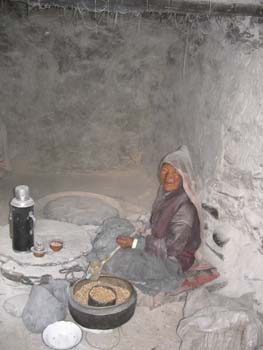 |
Miss Sonam Yangzom is granding roasted
barley to make it Tsampa.Tsampa is made by using water mile
as there is no other machinaries in this region. a woman
has to stay in side a water mile for hours and hours putting
barley inside the hole of stone whell. to make 50kg of Tsampa,
it takes about three hours.
|
|
"Tsoks" one of various foods
made out of Tsampa. The term Tsok can be translated as offering.
It literally means to earn good karmas. Tsoks are ritually
offered to Boudhas and then, ask Boudhas to bless the Tsoks.
When the ritual process is completed, Tsoks are considered
as blessing and can't be treated as normal foods.
The main recipes for Tsok include Tsampa,
butter, cheese, jiggery, and water. After making Tsok shape
as you can see, Tsoks are red colored and put three dots of
butter known as Kargen: white ornaments. |
|
Mr. Tsering
Konchok is well unknown for his skills at carving wood. He
is the master of carpenter. The villagers say, " he carves
wood like butter". His works can be seem in the monasteries
and individual houses in Limi.
As you can imagine, all works at the village
are done with simple tools. Tsering has no education in geometry
and all his measurement are taken length either his hands,
or arms. |
|
Most household has a shrine,
where they place statues of Buddhas and holy books. Still
today, carpenters in Limi carve various wooden furnitures
and alters. |
|
Mr. Rangdol work as wood-worker.
He make household wooden utentils, ladders, doors, and furnitures.
Some of his products are sold in Purang; western Tibet, in
the exchange of salts, tea, rice, carrocine and other foods
and requirementsb |
|
These people are making
producing cooking oil. The system is that first smash the
mustard seeds, second, cook the seeds, third, pack the seeds
in a bag, fourth tie the bag around a strong rope, fifth place
the seed bag between a specially designed stone and a strong
log a foot wide and 8 feet long, sixth place big stones on
top of the log.
The process is repeated at least two.
The left-over mustard seeds are feed to animails and known
to make them very strong. |
|
These work
are growing vegestables. Each family has their own vegetable
field. Nowadays, people grow several types of vegetables such
as radish, lates, potatos, and so on. |
|
These Nepalese
blacksmiths makes farming tools for Limi people. As it is
a part of Tibetan culture to make different caste of people
like Indian. Blacksmith are known as the lowest caste and
physical even contact is avoided. Therefore, in three villages
of Limi has no single blacksmith although caste of a family
is traced to bloodline and no has the power to change it.
|
|
These men are
building a house. As you can see, contrets are solely made
out of stones. Enternal and external plastering with mud.
Doors and windows are made out of wood and roofing is done
with log, bush, and mud. |
|
This woman
is spinning string to make clothing like "Ges":
Tibetan long dress. Women makes fine strings out of wool.
Then, three string combine together to make one strong string.
Then, next process is to weave the strings to make fabric.
To complete a "Ges" takes minimum two years for
a woman. A woman has so many other things to do. There is
a saying, "don't fold your hands up unless you don't
have fingers". This means, you need to do something while
you are in home. The saying is absolutely true because all
villagers have somethings to do whenever and wherever they
are. |
|
These women
are carrying fire-wood. One of the parmanent women's works
in Limi is to go to collect fire woods. A local rules says,
"a stem of tree which can hold a small bird is barley
full of Ba-Sar-Gang". This rule says, if you cut off
a stem of a living tree, you are penalized to pay about a
one Kilogram of barley. Ba-Sar-Gang is a measurement. The
local rules of Limi were the laws of Tibet when Tibet was
a free country. To collect cooking-wood is one of the most
difficult women's work. Especially, because of few unfortunate
death incidents, many women hate to cross rivers with wood
loads on their backs.
Many women's families have to collect
fire-wood for the village monasteries as their serve or payment
to the monastery. The monasteries use large quantities of
woods. |
|
The men of
Limi travel and bring foods and other things home. In Limi,
there is no local shop or store to buy simple things as matches,
salt, tea. Every family has to go to purchase their needs
either from Purang, western Tibet or Simikot, the Humla district
headquater town. Both destinations are no close from Limi.
To get to Purang, they have to travel two or three days. Some
times, they have to pass the Chineses border check-post. To
get to Simikot, it takes three days. The path they have is
only a meter wide. Some part of journey get really difficult
to travel, espacially when they have new animals to bring
to Limi. |
|
|
Elderly people
enjoy the sunlight and "Chang" Tibetan barley wine.
Many old men and women recite Mantras with their prayer wheel
and rosary. There are several common mantras known by all
people and each mantra stand for essence of a particular Buddhas'
teaching. |
|
This
woman is fetching water with her son. |
|






